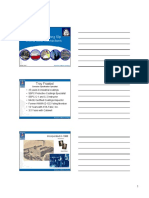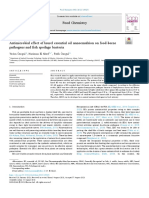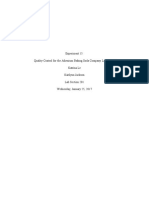Typical Desuperheater Installations: Block 15
Typical Desuperheater Installations: Block 15
Uploaded by
Omprakash_janaCopyright:
Available Formats
Typical Desuperheater Installations: Block 15
Typical Desuperheater Installations: Block 15
Uploaded by
Omprakash_janaOriginal Description:
Original Title
Copyright
Available Formats
Share this document
Did you find this document useful?
Is this content inappropriate?
Copyright:
Available Formats
Typical Desuperheater Installations: Block 15
Typical Desuperheater Installations: Block 15
Uploaded by
Omprakash_janaCopyright:
Available Formats
Block 15 Desuperheating
Typical Desuperheater Installations Module 15.4
Module 15.4
Typical Desuperheater
Installations
The Steam and Condensate Loop
15.4.1
Typical Desuperheater Installations Module 15.4
Block 15 Desuperheating
Typical Desuperheater Installations
Installation
There are a number of important considerations to take into account when installing a
desuperheater, namely:
o
The properties of the cooling water.
The installation of the desuperheater itself.
The ancillary components required.
The control valves used on the cooling water line and the superheated steam line.
A generalised installation of an in-line desuperheater is shown in Figure 15.4.1.
Pressure controller
Pressure
regulating
control valve
Safety
valve
Desuperheater
Superheated
steam
supply
Temperature
regulating
control valve
Temperature
controller
Non
return
valve
Cooling
water
Fig. 15.4.1 A typical in-line desuperheater installation
Properties of the cooling water:
o
Temperature - The most effective desuperheating will be achieved using cooling water that
is hot, preferably as close to the saturation temperature as possible. However, cooling water
temperatures as low as 5C could be used if absolutely necessary.
The use of hot water has the following advantages:
- It minimises the time period for which water particles are suspended in the steam.
- It evaporates more quickly.
- It minimises the amount of water falling to the inside walls of the pipework.
There are however, two disadvantages to using high temperature cooling water:
1. The higher the temperature of the cooling water, the greater the required flowrate due to
its lower cooling effect.
2. Unless a supply of the water at the required temperature is available, additional heating
mechanisms may have to be incorporated.
Due to the benefits of using hot water, it is logical to insulate the hot water supply pipes to
minimise heat loss, and to protect personnel.
15.4.2
The Steam and Condensate Loop
Block 15 Desuperheating
Typical Desuperheater Installations Module 15.4
Quality - The quality of the injected water is important. The Total Dissolved Solids (TDS) content
of the injection water should be as low as possible, as any solids that come out of solution will be
deposited on:
- The faces of valves.
- The small orifices in the desuperheater nozzles.
- The inner side of the piping downstream of the desuperheater.
In addition to reducing the TDS levels, all cooling water should be passed through a suitable
strainer installed before the water control valve.
o
Pressure and flowrate - As mentioned in Module 15.2, the pressure of the cooling water,
along with the area of the nozzles, determines the flow of cooling water into the desuperheater.
Table 15.3.1 shows the typical minimum pressures (above the superheated steam pressure)
required for each type of desuperheater. It should be noted that these might vary between
manufacturers and for different steam pressures.
If a booster pump is used, a spill back line will be required to ensure that there is always
sufficient flow through the pump at times of low cooling water demand.
Control - A pressure drop will inevitably be required over the water control valve. When using
cooling water close to saturation temperature, care is needed to ensure that the pressure drop
is not large enough to cause the water to flash into steam.
An equal percentage characteristic plug in the water control valve may be selected, which will
usually complement the pump characteristic.
Source - The availability of water at high pressure and temperature may be difficult. There are
a number of possible sources of the cooling water; and options include:
- Water from the pressure side of the boiler feedpump (providing the boiler uses modulating
level control).
- De-mineralised water.
- Condensate.
- Town water. This however may require treatment to improve the quality, otherwise salts may
be deposited on the inside of the desuperheater downstream pipework.
Desuperheater installation
The total installed length of a desuperheater station will vary with size and type, but it is typically
about 7.5 m.
Most desuperheaters can be installed in any direction (the variable orifice type is a notable
exception), but if installed vertically, the flow should be upwards. The venturi type is best installed
in a vertical pipe with the flow in the upward direction, as this aids mixing of the water and the
steam. However, such installations are not usually possible due to the vertical space required.
Superheated steam pressure control
Although it is possible to design desuperheater installations to operate with varying upstream
pressures, it is much simpler if a constant supply pressure is maintained.
The amount of cooling water added is controlled by the temperature of the steam after the
desuperheater. The higher the temperature, the more the control valve will open, and the
greater the amount of water added. The target is to reduce the steam temperature to within a
small margin of the design discharge temperature.
If the superheated steam supply pressure is increased, the saturation temperature will also increase.
However, the set value on the coolant controller will not change, and an excessive amount of
water will be added, resulting in wet steam.
Pressure sensors used in the control of the superheated steam pressure should ideally be located
at the point of use, so that the pressure control valve can compensate for any line loss between
the desuperheater and the point of use.
The Steam and Condensate Loop
15.4.3
Typical Desuperheater Installations Module 15.4
Block 15 Desuperheating
Temperature sensor positioning
The minimum distance from the point of water injection to the temperature sensing point is
critical:
o
If the sensor is too close to the water injection point, the mixing of the steam and the water
will not have been completed, and the temperature sensor will give a false output.
If the sensor is too far away, it will make the installation unnecessarily long.
The minimum installation distance will vary between different types of desuperheater and with
different manufacturers. It is usually specified as a function of the temperature difference between
the required outlet temperature and either the inlet temperature or the coolant temperature.
Figure 15.4.2 shows a typical manufacturers sensor positioning chart.
Difference between saturation and outlet temperatures (C)
125
100
75
50
25
24
22
20
Distance to sensing point (m)
18
Single nozzle
axial injection
type
16
14
12
10
8
Variable orifice
type
6
4
2
0
100
50
150
200
Difference between coolant and outlet temperatures (C)
250
Fig. 15.4.2 Positioning of the temperature sensor
Separator station
Efficient drainage of the pipework following the desuperheater is essential. To ensure that water
cannot accumulate at any point, the pipe should be arranged to fall approximately 20 mm per
metre in the direction of flow, and should be provided with a separator station.
The steam trap used to drain the separator should be carefully selected to prevent air binding,
and the discharge pipe from the steam trap should have ample capacity to deal with the drainage
and it should be fixed as near to vertical as possible. In addition, there must be sufficient space
in the drainage pipe for the water to flow down and air to pass up the pipe. The steam trap must
also be able to withstand superheat conditions.
On critical applications, for example, prior to a turbine, a separator is even more important; the
separator station will remove entrained water in the case of control failure, and prevent too
much water being added to the steam.
15.4.4
The Steam and Condensate Loop
Block 15 Desuperheating
Typical Desuperheater Installations Module 15.4
Isolation valves
To allow maintenance to be safely carried out, isolation valves are recommended upstream of:
o
The superheated steam pressure control valve.
The desuperheater.
The cooling water supply.
Typically, these should be installed approximately, but no less than 10 pipe diameters from the
item they are isolating.
Safety valve
A safety valve may be required to protect equipment downstream of the desuperheating station
from overpressure, in the event of failure of the pressure control station.
It is necessary to ensure discharge pipework from the safety valve is led away to a safe area. This
is of particular importance as high temperature superheated steam may be discharged.
Temperature and pressure ratings
Most equipment to be used on steam systems is designed with saturated steam in mind. It is
therefore important that all equipment used in a desuperheater station will tolerate both the
maximum temperature and pressure of the superheated steam.
Most equipment will have specified pressure and temperature limitations that are based on the
nominal pressure (PN) rating of the material and the specific design of the device. By definition,
the PN rating is the maximum pressure that a material can withstand at 120C. For example, a
PN16 rating means that the material will withstand a pressure of 16 bar g at 120C. At higher
temperatures, the maximum pressure will decrease, however, the exact relationship varies and
depends on the material.
In addition, components such as gaskets, fasteners and internal components may have a further
limiting effect on the maximum temperature and pressure.
45
Pressure (bar g)
40
30
PN40
25
20
PN25
16
10
PN16
100
120
140
160
180
200
220
240
260
280
300
Temperature (C)
Fig. 15.4.3 PN rating - Temperature / pressure limitations
Controls
The selection and installation of the control devices to be used in a desuperheater station are an
important consideration, as they can affect the overall turndown of the desuperheater. If the
controls installed have a lower turndown ratio than the desuperheater itself, the turndown of the
desuperheater station will be reduced (refer to Module 15.2)
Further information on basic control theory and practice can be found in Blocks 5 to 8 inclusive.
The Steam and Condensate Loop
15.4.5
Block 15 Desuperheating
Typical Desuperheater Installations Module 15.4
Selection
When selecting a suitable type of desuperheater for a particular application, the following factors
need to be considered:
o
Separator station - This is probably one of the most important considerations, as the different
types of desuperheater vary significantly in the range of superheated steam flowrates that can
be effectively desuperheated.
It is important to note here that, although ensuring that the device will have sufficient turndown
for the flow likely to be encountered, it is important not to specify more turndown capability
than is really needed. This predominantly affects cost, but it can also lead to poor system
performance. Poor performance is often aggravated by the fact that most desuperheaters
tend to perform better at the higher end of the specified flowrates and a system designer
would tend to allow for increases in capacity due to expansion. As an extreme example, if the
maximum flow specified was ten times the current requirement (in order to take into account
future growth), the desuperheater will operate between 1 and 10% of its full flowrate instead
of the 10% to 100% it is designed for.
Desuperheated steam temperature - As seen in the previous Module, different types of
desuperheater are capable of reducing the steam temperature to within several degrees of
the saturation temperature. For example, if desuperheated steam temperatures within 5C of
the saturation temperature (TS) were required, a venturi or variable orifice type desuperheater
would be selected (see Table 15.3.1).
Generally, where some degree of residual superheat can be tolerated, the desuperheated
steam temperature should be as high above saturation as possible. This is beneficial for several
reasons:
1. Cost a close approximation to saturation temperature is generally only achievable with
the more costly types of desuperheaters.
2. Controller sensitivity this may be a problem where the desuperheated steam temperature
is required to be close to the saturation temperature. Limited controller sensitivity is one of
the reasons why most desuperheaters are limited in their approach to saturation temperature.
For example, if a controller had a sensitivity of 5C, it would not be able to distinguish
between saturation temperature and 5C above. If such a controller interpreted the steam
temperature at 5C above TS, and the steam were actually at TS, it would increase the flow of
cooling water. But since the temperature of the saturated steam will not decrease (due to the
latent heat of evaporation), the controller will add increasingly more coolant as it would still
believe the system to be at 5C above TS. This will result in very wet steam flooding the steam
main after the desuperheater station.
3. It becomes increasingly difficult to evaporate the cooling water as the superheated steam
temperature drops towards saturation, due to the reduced temperature difference between
the two.
4. The lower temperature difference also reduces the heat transfer rate between the water
and the steam, and therefore the water droplets have to stay in suspension for longer to be
evaporated. This increases the likelihood that the water particles will fall out of suspension in
the pipe. In order to prevent this from occurring, as the temperature approaches TS, the
velocity of the steam needs to be increased in order to create more turbulence.
Available coolant supply pressure - The choice of desuperheater type will also depend on
the availability of cooling water at the necessary pressure. It would provide a cost advantage
to use cooling water that is already available, for example, from the pressure side of a boiler
feedwater pump.
If the available pressure were not sufficient for a particular type of desuperheater, additional
pumping arrangements would have to be made.
15.4.6
The Steam and Condensate Loop
Block 15 Desuperheating
Typical Desuperheater Installations Module 15.4
A typical manufacturers selection chart is shown in Figure 15.4.4. It is based on the typical
performance and installation characteristics, which can be found in Table 15.3.1.
The method used to size a desuperheater will vary depending on the particular manufacturer
and the type of desuperheater, and therefore it is outside the scope of this publication.
Is required steam
flow turndown
<3:1
Yes
No
Is required steam
flow turndown
<5:1
Is final
temperature
>Ts + 10C
Yes
Is final
temperature
>Ts + 3C
Yes
No
No
Yes
Is coolant available
with superior pressure
>0.5 bar
Yes
Is coolant available
with superior pressure
>1 bar
Single
nozzle,
axial
injection
No
Yes
Venturi
type
No
No
No
No
Is required steam
flow turndown
<8:1
Is final
temperature
>Ts + 8C
Is coolant available
with superior pressure
>4 bar
Multiple
nozzle, axial
injection
(fixed area)
Yes
Yes
Yes
No
No
No
No
Is required
steam flow
turndown
<12:1
Is final
temperature
>Ts + 8C
Is coolant available
with superior pressure
>3.5 bar
Multiple
nozzle, axial
injection
(variable area)
Yes
Yes
Yes
No
No
No
No
Is required
steam flow
turndown
<50:1
Is final
temperature
>Ts + 6C
Is coolant available
with superior pressure
>steam pressure
Is atomising
steam
available
>4 bar
Yes
No
No
Is required
steam flow
turndown
>50:1
Yes
Yes
Is final
temperature
>Ts + 2.5C
No
Yes
Is coolant available
with superior pressure
>0.4 bar
Yes
No
Yes
Steam
atomising
type
Yes
Variable
office type
Fig. 15.4.4 Desuperheater selection chart
The Steam and Condensate Loop
15.4.7
Typical Desuperheater Installations Module 15.4
Block 15 Desuperheating
Typical applications
Desuperheaters are mainly applied in two areas:
1. Power generation - Desuperheaters are mainly used to reduce the temperature of steam
emitted from turbine bypass systems to an efficient level for operation on other parts of the plant
requiring saturated steam for heat transfer purposes.
2. Process industry - In process industries, desuperheaters are used as part of a system for
reducing the temperature and pressure of steam from boilers to economical levels of operation.
Table 15.4.1 shows some common application examples in particular industries.
Table 15.4.1 Typical applications for desuperheaters in process industries
Industry
Applications
Paper and board
Paper drying machines.
Food
Steam cooking kettles.
Evaporator heat exchangers.
Textiles
Fabric finishing autoclaves.
Tobacco
Tobacco leaf drying plants.
Reactor heater jackets and coils.
Distillation plants.
Chemical and pharmaceutical
Methanol plants.
Sulphur plants.
Polymerisation plants.
Chemical.
Vacuum distillation start-up heaters.
Glycol and ethylene plants.
Aromatics recovery.
Vinyl chloride plants.
Thermal and catalytic crackers.
Vacuum distillation.
Oil and petrochemical
Refineries
Brewing and distilling
Boiler and turbine installations
15.4.8
Polymerisation plants.
Sulphur plants.
De-salting.
Isomerisation processes.
Thermal and catalytic crackers.
Vacuum distillation.
Sulphur plants.
Steam heating systems.
Power generation.
Shipbuilding.
The Steam and Condensate Loop
Block 15 Desuperheating
Typical Desuperheater Installations Module 15.4
Questions
1. Which of the following are advantages of using hot, instead of cold water as the cooling
fluid in a desuperheater?
i. Water particles spend less time suspended in the steam.
ii. Less water impinges on the inside walls of downstream pipework.
iii. It reduces the absorption length as the water is evaporated more quickly.
a| i only
b| ii only
c| i and ii
d| i, ii and iii
2. Why is tap water not an ideal source for cooling water for most types of desuperheater?
a| It is generally available at low pressures
b| It is at room temperature
c| High TDS levels can result in solids falling out of suspension
d| All of the above
3. Why do most desuperheaters not reduce the temperature of the superheated steam
to saturation temperature?
i. The decrease in temperature difference between the cooling water and the steam
makes this difficult.
ii. The sensitivity of the cooling water flowrate controller will cause flooding of the
pipework at temperatures close to saturation.
iii. Producing steam at saturation temperature is not beneficial.
a| i only
b| ii only
c| i and ii
d| i, ii and iii
4. Why is it important not to over specify the turndown ratio of a desuperheater?
a| It will increase the cost of the desuperheater station
b| It will increase the risk of the downstream pipework flooding
c| It will increase the amount of cooling water required for a given superheated steam flowrate
d| The statement is false and all desuperheaters should be specified with a significantly larger
turndown to allow for expansion
The Steam and Condensate Loop
15.4.9
Typical Desuperheater Installations Module 15.4
Block 15 Desuperheating
5. Using the selection chart (figure 15.4.4), which type of desuperheater would be most
suitable for use in a sugar refinery for the following conditions? The site already has a
boiler producing 10 bar g saturated steam. Coolant is available at 14 bar g.
Maximum superheated steam flow
16 000 kg / h
Minimum superheated steam flow
Final temperature
2 000 kg / h
TS + 7C
a | Tube bundle type
b | Multiple nozzle, axial injection type
c | Steam atomising type
d | Variable orifice type
6. Which of the following considerations have to be made when selecting a type of
desuperheater?
a | Turndown ratio
b | The required final temperature
c | The availability of cooling water
d | All of the above
Answers
1: d, 2: d, 3: c, 4: a, 5: c, 6: d
15.4.10
The Steam and Condensate Loop
You might also like
- Operation - Manual Sondex A/S SFD 6: Customer: Newbuilding No: Order No.: Sondex Order No.: Encl.Document132 pagesOperation - Manual Sondex A/S SFD 6: Customer: Newbuilding No: Order No.: Sondex Order No.: Encl.AlexDor100% (2)
- 0708 1 Abs PDFDocument7 pages0708 1 Abs PDFAlexander ShvetsNo ratings yet
- Literature Review Heavy MetalDocument14 pagesLiterature Review Heavy MetalnazatulNo ratings yet
- 750-326 Blowdown Separator 11 2015Document10 pages750-326 Blowdown Separator 11 2015osamaNo ratings yet
- Mollie ChartDocument15 pagesMollie ChartKriz EarnestNo ratings yet
- Venta: Two-Way Pressure Balanced Valve PN 16 (232 Psi)Document5 pagesVenta: Two-Way Pressure Balanced Valve PN 16 (232 Psi)DedeKurniawanNo ratings yet
- Stanton Premier BoilerDocument28 pagesStanton Premier Boilermyousif63No ratings yet
- Flash Vessel Spirax Sarco FV-FINALDocument3 pagesFlash Vessel Spirax Sarco FV-FINALkawkatr100% (1)
- Thermal Cracking:: Stream Number Stream Make SourceDocument3 pagesThermal Cracking:: Stream Number Stream Make SourcejohnNo ratings yet
- ECO4Document9 pagesECO4محمد عباس نصارNo ratings yet
- Cooling Tower SystemDocument33 pagesCooling Tower SystemCzarSASNo ratings yet
- IGardElectricalSystemGround - High Resistance Grounding 3 Wire SystemDocument6 pagesIGardElectricalSystemGround - High Resistance Grounding 3 Wire SystemiakongNo ratings yet
- University of Lahore, Islamabad Campus: Nozzle Thermpdynamics-Ii Engr. Babar AshfaqDocument65 pagesUniversity of Lahore, Islamabad Campus: Nozzle Thermpdynamics-Ii Engr. Babar AshfaqGhaffar KhanNo ratings yet
- EVI (Enhance Vapour Injection) Scroll COMPRESSORSDocument10 pagesEVI (Enhance Vapour Injection) Scroll COMPRESSORSambuenaflorNo ratings yet
- The Importance of Steam Quality For Steam-System Process OperationDocument4 pagesThe Importance of Steam Quality For Steam-System Process OperationBramJanssen76No ratings yet
- Lecture 2 Petchem 2021 MoodleDocument28 pagesLecture 2 Petchem 2021 MoodleCarlos francisco PerézNo ratings yet
- Introduction To Compressible FlowDocument14 pagesIntroduction To Compressible Flowram kishor singhNo ratings yet
- DeaeratorDocument8 pagesDeaeratorfjoesandi100% (1)
- Chiller Selection MethodDocument9 pagesChiller Selection MethodAbdullah.N FAAliNo ratings yet
- Desiccant CoolingDocument14 pagesDesiccant CoolingSumit DasNo ratings yet
- Heat Recovery Steam GeneratorDocument21 pagesHeat Recovery Steam GeneratorAbdullah AhmedNo ratings yet
- Variable Speed Pumps KSBDocument12 pagesVariable Speed Pumps KSBMuhammadUsmanNo ratings yet
- Steam NozzlesDocument50 pagesSteam NozzlesPRAVEEN100% (1)
- 3.2 Electric Motors - Revised (Table Format)Document8 pages3.2 Electric Motors - Revised (Table Format)Sumit AgrawalNo ratings yet
- FP Planning Requirements & Design GuidelineDocument19 pagesFP Planning Requirements & Design GuidelinelkakeanNo ratings yet
- 04 Axial PumpDocument26 pages04 Axial PumpRicky SeptianNo ratings yet
- Thermal Conversion ProcessesDocument24 pagesThermal Conversion ProcessesAl Jawad100% (1)
- Flowcheck Guide To PumpsDocument3 pagesFlowcheck Guide To PumpsFA AyNo ratings yet
- Steps of Developing A Cost Estimating RelationshipDocument2 pagesSteps of Developing A Cost Estimating RelationshipSenelwa AnayaNo ratings yet
- Chilled Water DistributionDocument44 pagesChilled Water DistributionOMARNo ratings yet
- 24338-8.0100.00.0 - SPR Ngplade IntroduktionDocument4 pages24338-8.0100.00.0 - SPR Ngplade IntroduktionDinesh KumarNo ratings yet
- Aspen Repot Lab 4Document8 pagesAspen Repot Lab 4Mohd Hisyamuddin Mohd AminudinNo ratings yet
- NG Engineering by Engr DR CIC AnyadiegwuDocument31 pagesNG Engineering by Engr DR CIC Anyadiegwudavidchinedu008No ratings yet
- Cooling Tower Design Handbook PDF - 2Document20 pagesCooling Tower Design Handbook PDF - 2num0067No ratings yet
- Water Distribution ManualDocument20 pagesWater Distribution ManualOxfamNo ratings yet
- Comparison of Refrigerants R410a and R404aDocument99 pagesComparison of Refrigerants R410a and R404aLuis CarlosNo ratings yet
- RELAP5 Simulation of CANDU Station Blackout AccideDocument20 pagesRELAP5 Simulation of CANDU Station Blackout AccideWhite HeartNo ratings yet
- Steam Turbine CogenerationDocument5 pagesSteam Turbine CogenerationChemical engineeringNo ratings yet
- RefineryDocument14 pagesRefinerykrishna sharmaNo ratings yet
- Cause & Effect Diagram For InterlocksDocument1 pageCause & Effect Diagram For InterlocksMarioNevesNo ratings yet
- Heat PipesDocument67 pagesHeat PipesLibin LalNo ratings yet
- Thermo Flow Brochure 2002Document14 pagesThermo Flow Brochure 2002marco_a_salasNo ratings yet
- Flow Control Custody Transfer Metering of Oil & Gas - 1Document3 pagesFlow Control Custody Transfer Metering of Oil & Gas - 1atorresh090675No ratings yet
- Airconditioning DistributionDocument5 pagesAirconditioning DistributionSanthosh LingappaNo ratings yet
- PSR PPSXDocument19 pagesPSR PPSXpmahesh268No ratings yet
- Thermal-Hydraulic Modelling of Forsmark 1 NPP in TRACE - 2006Document86 pagesThermal-Hydraulic Modelling of Forsmark 1 NPP in TRACE - 2006Otso CronvallNo ratings yet
- Pressure Losses in Pipe Network Name: University: CodeDocument7 pagesPressure Losses in Pipe Network Name: University: CodeshagsNo ratings yet
- Net Positive Suction Head NPSH PDFDocument5 pagesNet Positive Suction Head NPSH PDFSanthosh ThekkethottiyilNo ratings yet
- Natural Gas Process InstrumentationDocument4 pagesNatural Gas Process InstrumentationaaashfNo ratings yet
- High Rise Building Fuel Systems 01 0Document11 pagesHigh Rise Building Fuel Systems 01 0eimrehNo ratings yet
- Steam Distribution QualityDocument9 pagesSteam Distribution QualityRoseMalyn Alfonso GagaraNo ratings yet
- HIU Range Design GuideDocument24 pagesHIU Range Design Guidesachinsaklani23No ratings yet
- Excel Project Consultants Private Limited: (A Total Service Solution Provider For Thermal Power Plants)Document32 pagesExcel Project Consultants Private Limited: (A Total Service Solution Provider For Thermal Power Plants)Sarah FrazierNo ratings yet
- Inrush Current in Capacitor BankDocument11 pagesInrush Current in Capacitor BankRitaban R. BanerjeeNo ratings yet
- Heat Exchanger Effectiveness PDFDocument5 pagesHeat Exchanger Effectiveness PDFfrilofhNo ratings yet
- Basics of ThermodynamicsDocument341 pagesBasics of ThermodynamicsVinh VuNo ratings yet
- Sustainable Cooling Technologies PDFDocument54 pagesSustainable Cooling Technologies PDFAyesha ParveenNo ratings yet
- DESUPERHEATERDocument4 pagesDESUPERHEATERghkashyap1100% (1)
- 62 enDocument6 pages62 enshaonaaNo ratings yet
- Ariston 600 Europrisma Manual V2.1Document16 pagesAriston 600 Europrisma Manual V2.1ciohaniNo ratings yet
- CONDENSER SchemeDocument47 pagesCONDENSER SchemeAbhishek Sinha100% (1)
- FF Applications in IntoolsDocument50 pagesFF Applications in IntoolsOmprakash_janaNo ratings yet
- Fdocuments - in - Ts of Capacitor BankDocument10 pagesFdocuments - in - Ts of Capacitor BankOmprakash_janaNo ratings yet
- Anna University Information BroucherDocument38 pagesAnna University Information BroucherVinitgaNo ratings yet
- 1994 LevelDocument11 pages1994 LevelOmprakash_janaNo ratings yet
- LCD Screen AdvantagesDocument4 pagesLCD Screen AdvantagesOmprakash_janaNo ratings yet
- Max - E2: Low Voltage 3-Phase Induction Motors 0.18kW To 185kWDocument36 pagesMax - E2: Low Voltage 3-Phase Induction Motors 0.18kW To 185kWOmprakash_janaNo ratings yet
- Vol 28015Document10 pagesVol 28015Omprakash_janaNo ratings yet
- Hydro ComDocument18 pagesHydro ComOmprakash_janaNo ratings yet
- Westermo Ds Adsl-350 enDocument3 pagesWestermo Ds Adsl-350 enOmprakash_janaNo ratings yet
- Notifier 500Document4 pagesNotifier 500Omprakash_jana0% (1)
- Electrical Issues For Electro Chemical PlantsDocument7 pagesElectrical Issues For Electro Chemical PlantsOmprakash_janaNo ratings yet
- AKS 41-41U Phase OutDocument1 pageAKS 41-41U Phase OutOmprakash_janaNo ratings yet
- Corrosion and Its EffectsDocument14 pagesCorrosion and Its EffectsOmprakash_janaNo ratings yet
- Cleaning and DesinfectionDocument38 pagesCleaning and DesinfectionKamil OwsianieckiNo ratings yet
- Loctite 603: Technical Data SheetDocument3 pagesLoctite 603: Technical Data SheetibrahimNo ratings yet
- NMDC BacheliDocument32 pagesNMDC BacheliAnurag MandalNo ratings yet
- Stress Analysis of GRP-GRE-FRP PipingDocument4 pagesStress Analysis of GRP-GRE-FRP PipingHmd MokhtariNo ratings yet
- Vda 232-101Document23 pagesVda 232-101Imperio de Aarón López RamírezNo ratings yet
- Bismite O: Crystal DataDocument1 pageBismite O: Crystal DataAgenteNo ratings yet
- STEM ALL Sciences علمي رياضة VERSION LO's 2020Document85 pagesSTEM ALL Sciences علمي رياضة VERSION LO's 2020mohab harfoushNo ratings yet
- 21Document37 pages21황선영No ratings yet
- Answers To Chemistry Homework 5.1 From Particles To Solutions P. 178 # 8,9,10Document6 pagesAnswers To Chemistry Homework 5.1 From Particles To Solutions P. 178 # 8,9,10fantasy373No ratings yet
- Enviromental ProjectDocument23 pagesEnviromental Projectselemon emiruNo ratings yet
- Liquid Lubrication in SpaceDocument28 pagesLiquid Lubrication in SpacelufabaoNo ratings yet
- Mechanical Seal-Part OneDocument2 pagesMechanical Seal-Part Oneusmaniqbal15No ratings yet
- CO-ORDINATED SCIENCES 0654/32 Paper 3 Theory (Core)Document24 pagesCO-ORDINATED SCIENCES 0654/32 Paper 3 Theory (Core)José Antonio Álvarez CuberoNo ratings yet
- P2 Excel 01Document7 pagesP2 Excel 01Cyrus HongNo ratings yet
- FinalDocument17 pagesFinalKashif NaukhezNo ratings yet
- SEA Priming and Painting Slip Critical Steel Connections 120510Document24 pagesSEA Priming and Painting Slip Critical Steel Connections 120510muathNo ratings yet
- DetergentsDocument4 pagesDetergentsAnindya RayNo ratings yet
- Stoichiometry 1Document52 pagesStoichiometry 1Mero Miro100% (1)
- Jurnal 1.3Document8 pagesJurnal 1.3Edi SaputraNo ratings yet
- State of The Art Study On Aging of Asphalt Mixtures and Use of Antioxidant AdditivesDocument20 pagesState of The Art Study On Aging of Asphalt Mixtures and Use of Antioxidant AdditivesadinaNo ratings yet
- Aqa Planner 2024Document16 pagesAqa Planner 2024Abayomi Samuel LanreNo ratings yet
- Bio Inorganic Short Notes by Dr. Kuldeep GargDocument5 pagesBio Inorganic Short Notes by Dr. Kuldeep Gargwww.sachinkumar1086No ratings yet
- Modular Ceiling BrochureDocument20 pagesModular Ceiling BrochureShivansh Singh GautamNo ratings yet
- Quality Control Baking Soda Lab ReportDocument22 pagesQuality Control Baking Soda Lab ReportKatrina Le100% (6)
- Research On The Design of Hydrogen Supply System o - 2018 - International JournaDocument7 pagesResearch On The Design of Hydrogen Supply System o - 2018 - International JournaSimone AlessandriniNo ratings yet
- API Product List July 2019Document5 pagesAPI Product List July 2019মোঃ এমদাদুল হকNo ratings yet
- Acids-Bases Review Game 2Document51 pagesAcids-Bases Review Game 2api-269495692No ratings yet
- Nomenclature of Electron-Transfer Proteins: Nomenclature Committee of The International Union of Biochemistry (NC-IUB)Document13 pagesNomenclature of Electron-Transfer Proteins: Nomenclature Committee of The International Union of Biochemistry (NC-IUB)gustaboo3584No ratings yet
- Set 1 Mcqs CarbohydratesDocument27 pagesSet 1 Mcqs CarbohydratesAlaa ElmalahNo ratings yet






































































































